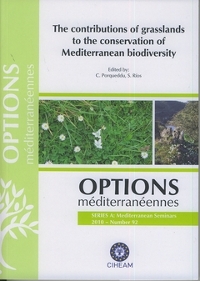| Article précédent | p. 199-203 | Article suivant |
Influence of maturity stage of forage grasses and leguminous on their chemical composition and in vitro dry matter digestibility
In this study we investigated the effect of maturity stage on chemical composition, in vitro dry matter digestibility (IVD) and volume of gas produced at 24 h (G24) of forages from Avena sativa L. (oats), Trifolium alexandrinum (berseem), Vicia sativa L. (vetch), Avena sativa-Vicia sativa (OV) and Avena sativa- Trifolium alexandrinum (OB) mixtures collected at progressive morphological stages (S1, S2, S3, S4) from the emergence to the beginning milky maturation of the grain and the pod stage. Lowest CP content (56 g/kg DM) was recorded for A. sativa-T. alexandrinum at the mature stage (S4), whilst V. sativa collected at young stage (S1) had the highest content (274 g/kg DM). NDF content varied from 423.8 g/kg DM to 760.9 g/kg DM, and ADF content varied between 291.5 g/kg DM (vetch-oat) and 462 g/kg DM (vetch collected in S3). For all studied species the highest IVD coefficient (>0.800) corresponded to forage sampled at young maturity stage (S1) and the lowest values (0.500) to mature stage (S4) of Gramineae and mixtures. The same trend was followed by G24. It is pertinent to mention that for all studied species with increasing maturity CP content, IVD and G24 declined linearly while NDF and ADF contents followed an opposite trend. It was concluded that CP, IVD and G24 of Gramineae (oat) can be enhanced by its association with leguminous specially vetch, the most common combination in Tunisian agricultural systems.
Dans cette étude, nous avons déterminé l'effet du stade de maturité sur la composition chimique, la digestibilité in vitro (DIV) et le volume de gaz produit à 24 h d'incubation des fourrages de l'Avena sativa L., Trifolium alexandrinum (B), Vesce sativa L., vesce-avoine (VA) et avoine-trifolium (AB) collectés à des stades morphologiques différents, de la montaison (S1) jusqu'au stade pâteux laiteux (S4). Les contenus les plus faibles en protéine brute (PB) ont été enregistrés dans l'association AB collecté au stade S4 (56 g/kg MS), alors que les contenus les plus élevés (274 g/kg MS) ont été trouvés dans la vesce en debut de végétation (S1). Les teneurs en FND varient entre de 423,8 et 761 g/kg MS et les contenus en FAD oscillent dans entre 291 et 462 g/kg MS. Pour toutes les espèces étudiées, les coefficients de DIV ont été élevés (>0,800) au début du stade végétatif et faibles (0,500) vers la fin de croissance végétative (S4) des graminées et des associations. De même G24 a suivi la même allure. Il convient de mentionner que pour toutes les espèces étudiées et en fonction du grade de maturité du fourrage, PB, DIV et G24 ont marqué une chute décroissante à l'opposé de FND et ADF. On a conclu que les teneurs en PB, DIV et G24 de l'avoine peuvent être améliorées suite à son association avec les légumineuses en particulier avec la vesce, technique souvent appliquée en Tunisie dans les systèmes d`élevage.
- [ Afficher ]
- [ Télécharger ]
- [ Exporter la citation ]
Vous pouvez télécharger la citation au format :
- [ Imprimer ]
-
Mots-clés
COMPOSITION CHIMIQUE, DIGESTIBILITE, EXPERIMENTATION IN VITRO, GRAMINEE FOURRAGERE, LEGUMINEUSE FOURRAGERE, STADE DE DEVELOPPEMENT VEGETALCiter cet article
Ammar H., López S., Andrés S. Influence of maturity stage of forage grasses and leguminous on their chemical composition and in vitro dry matter digestibility. In : Porqueddu C. (ed.), Ríos S. (ed.). The contributions of grasslands to the conservation of Mediterranean biodiversity. Zaragoza : CIHEAM / CIBIO / FAO / SEEP, 2010. p. 199-203. (Options Méditerranéennes : Série A. Séminaires Méditerranéens; n. 92). 13. Meeting of the Sub-Network on Mediterranean Forage Resources of the FAO-CIHEAM International Network for the Research and Development of Pasture and Forage Crops, 2010/04/07-10, Alicante (Spain). http://om.ciheam.org/om/pdf/a92/00801242.pdf



